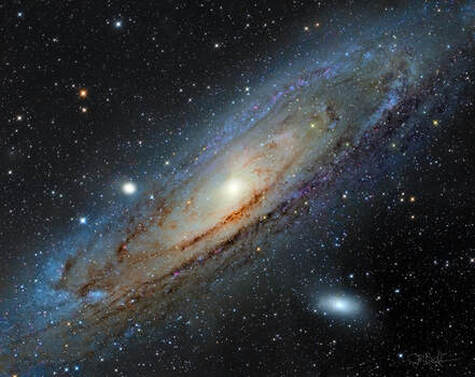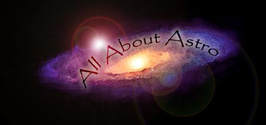| Shooting a mosaic, especially an 8-frame color LRGB image, is not for the faint of heart! But every now and then we astrophotographers get the urge to push our skills and our equipment. The result of such mosaics, like this one of the very familiar M31, Andromeda Galaxy, is to achieve fine resolution (detail) as delivered by the long focal length optics WITH the wide field of view typically given by shorter focal length scopes and lenses. Meaning? A huge galaxy such as Messier 31, Andromeda’s catalog designation, can be captured completely, yet in terrific detail. |
This galaxy (found within the constellation Andromeda) isn’t the closest galaxy to us, but it’s pretty close...only 2.5 million light years away. That’s 1.47 x 10^19 miles, if you need that perspective. As pictured, you could fit 7 or 8 of our moons across the disk of this galaxy from our sky perspective. It’s huge and it’s a naked eye object in most rural-to-suburban skies.
Oh, BTW, any star that you see in this image (click on it to see the full resolution image) is in our own Milky Way galaxy, since we have to look through our own neighborhood to see the next. Stars in Andromeda are too small to see from this distance, though you can witness clusters of them together, especially all the globulars that have their own set of designations.
How many stars are there in Andromeda? Well, you are staring at about 1 trillion stars, give or take a couple. That is about 4 or 5 times the number within our own galaxy.
One of the more intriguing aspects of M31 is that the light captured here first left that galaxy around 2.5 million years ago. In other words, looking into the sky is about as close to actual time travel as we can experience.
This Shot using instruments stationed at the Conley Observatory from Bortle 2 dark skies at the Comanche Springs Astronomy Campus near Crowell, Texas. Equipment includes the 12.5” RCOS Ritchey-Chretien (2857mm focal length), Paramount ME mount, and FLI Proline PL-16803 Astro CCD camera.
Software includes TheSkyX for acquisition, PixInsight for data calibration and mosaic “stitching,” and Adobe Photoshop CC for post-processing.
The grayscale for each of the 8 mosaic frames, which encompasses a amazing 10224 x 8112 pixel resolution, ranges from 90 minutes to 140 minutes per frame, which is right at 16 hours of total time for the grayscale alone.
Color is taken from two sources. First is from a 36 min DSLR image of the object I took last year using the Nikon D810a and a small Tak FSQ-85ed apo refractor. This gives most of the stars their colors, as well as a base hue for the galaxy itself. But most of the color data was taken using 5 binned RGB frames of the galaxy alone. This data, shot with the FLI PL-16803, is 2x2 binned averaging 2.5 hours of total time for each frame.
Total time for the image is approximately 29 hours of exposure.
it is, by far, the most ambitious image I've ever taken. It's not perfect, as processing such an image can be quite a challenge, but it's still a nice look at our massive neighbor, one that I hope you will enjoy!
Oh, BTW, any star that you see in this image (click on it to see the full resolution image) is in our own Milky Way galaxy, since we have to look through our own neighborhood to see the next. Stars in Andromeda are too small to see from this distance, though you can witness clusters of them together, especially all the globulars that have their own set of designations.
How many stars are there in Andromeda? Well, you are staring at about 1 trillion stars, give or take a couple. That is about 4 or 5 times the number within our own galaxy.
One of the more intriguing aspects of M31 is that the light captured here first left that galaxy around 2.5 million years ago. In other words, looking into the sky is about as close to actual time travel as we can experience.
This Shot using instruments stationed at the Conley Observatory from Bortle 2 dark skies at the Comanche Springs Astronomy Campus near Crowell, Texas. Equipment includes the 12.5” RCOS Ritchey-Chretien (2857mm focal length), Paramount ME mount, and FLI Proline PL-16803 Astro CCD camera.
Software includes TheSkyX for acquisition, PixInsight for data calibration and mosaic “stitching,” and Adobe Photoshop CC for post-processing.
The grayscale for each of the 8 mosaic frames, which encompasses a amazing 10224 x 8112 pixel resolution, ranges from 90 minutes to 140 minutes per frame, which is right at 16 hours of total time for the grayscale alone.
Color is taken from two sources. First is from a 36 min DSLR image of the object I took last year using the Nikon D810a and a small Tak FSQ-85ed apo refractor. This gives most of the stars their colors, as well as a base hue for the galaxy itself. But most of the color data was taken using 5 binned RGB frames of the galaxy alone. This data, shot with the FLI PL-16803, is 2x2 binned averaging 2.5 hours of total time for each frame.
Total time for the image is approximately 29 hours of exposure.
it is, by far, the most ambitious image I've ever taken. It's not perfect, as processing such an image can be quite a challenge, but it's still a nice look at our massive neighbor, one that I hope you will enjoy!


 RSS Feed
RSS Feed
